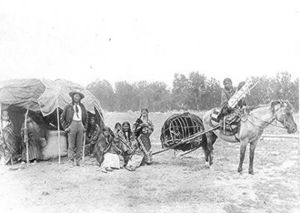- Travois
-
A travois (Canadian French, from French travail, a frame for restraining horses; also obsolete travoy or travoise) is a frame used by indigenous peoples, notably the Plains Indians of North America, to drag loads over land. The basic construction consists of a platform or netting mounted on two long poles, lashed in the shape of an elongated isosceles triangle; the frame was dragged with the sharply pointed end forward. Sometimes the blunt end of the frame was stabilized by a third pole bound across the two poles.
The travois was dragged by hand, sometimes fitted with a shoulder harness for more efficient dragging, or dragged by dogs or horses (after the sixteenth-century introduction of horses by the Spanish). A travois could either be loaded by piling goods atop the bare frame and tying them in place, or by first stretching cloth or leather over the frame to hold the load to be dragged.
Although considered more primitive than wheel-based forms of transport, on the type of territory where the travois was used (forest floors, soft soil, snow, etc.), rather than roadways, wheels would encounter difficulties which make them less efficient. As such the travois was employed by Coureurs des bois in New France's fur trade with the Plains Tribes.
Boy Scouts and similar groups still receive instruction on how to build a travois as a means of transporting a sick or wounded companion who cannot be left behind. It is possible for a person to transport more weight on a travois than can be carried on the back.
Gallery
Footnotes
Categories:- Native American culture
- First Nations culture
- First Nations history
- Human-powered vehicles
- Animal-powered vehicles
Wikimedia Foundation. 2010.






